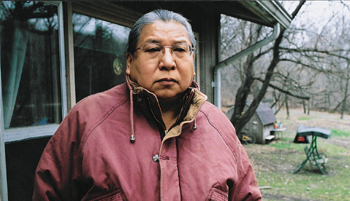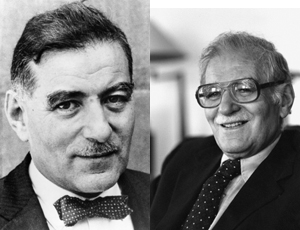 |
|
| Where the action was On Iowa’s Meskwaki Settlement, a group of Chicago anthropology students went beyond observation and tried to help their research subjects. Fifty-six years later, action anthropology is the stuff of footnotes—and Meskwaki memory. The only American Indian settlement in Iowa lies among the wooded slopes and marshy bottomlands of the Iowa River, an hour west of Cedar Rapids. The Meskwaki, whose name means “Red-Earth People,” are also a tenacious people. In the 18th century they fought the French in the western Great Lakes region and were nearly annihilated. The survivors eventually migrated to Iowa, where they remained until the government moved them to Kansas in the 1840s. In 1857 a group returned to Iowa and bought 80 acres with money raised by selling ponies and jewelry. The Meskwaki not only frustrated efforts to send them back to Kansas but also expanded their holdings many times over. Today they own more than 7,000 acres—11 square miles—and operate a school, a health clinic, tribal offices, a senior center, a housing department, and a casino whose profits provide each tribe member with a monthly “per cap” of approximately $1,800. Yet the Meskwaki, who number about 1,500, have long resisted assimilation into white society. They never took to farming, at least in the modern Iowan sense. Generations of missionaries failed to convert more than a few to Christianity. Most Meskwaki still follow their old religion, gathering in long wooden buildings with dirt floors to pray, dance, and feast in traditional clan ceremonies. Not only have they survived, but in many ways they are thriving.
That wasn’t the case in June 1948, when six Chicago graduate students arrived at Meskwaki Settlement for a summer of fieldwork. They were the first of 35 students, mostly from the U of C, who visited over the next decade to study the Meskwaki. The Fox Project, as it was eventually called, after the old French name for the tribe, was a kind of anthropological boot camp. The students would observe, ask questions, write papers—and learn to be anthropologists. They began conventionally enough, conducting interviews, attending ceremonies, and taking part, however awkwardly at first, in settlement life. But as they got to know the Meskwaki they became dissatisfied with their research. Torn between traditional ways and those of modern white society, the settlement was experiencing difficulties that seemed to demand another, more proactive response. The Meskwaki certainly expected one. Lisa R. Peattie, AM’50, PhD’68, now a professor emeritus of planning at MIT, recalls, “People kept complaining, ‘You keep asking all these questions. What’s in it for us?’ ” Over the next ten years the Fox Project tried to answer that question. In the process, an ordinary training assignment was transformed into an attempt to redefine anthropology. The Fox Project challenged the then-dominant ideal of disinterested science and instead experimented with combining research and helping, advancing knowledge while also doing good. Ambitious and full of pitfalls, the Fox Project tried to forge something more satisfying out of the morally fraught relationship between anthropologist and subject. Whether the approach ever worked, or even could work, is still disputed. But, for a moment, it seemed full of promise. In 1948 the Meskwaki had relatively little. Their unpainted one- or two-room frame houses lacked electricity, telephones, and indoor plumbing. Few owned cars; few had any education beyond high school. Some worked off the settlement, while others sought jobs in the military. Their poverty was not grinding, but jobs and money were scarce. Bitter disagreements made it difficult for the Meskwaki, who then numbered about 600, to work together as a community. Whites in Tama, a little railroad town three miles east, looked upon them as poor and hapless. The Chicago students viewed them differently. The students were young and green and easily caught up in the romance of American Indians and anthropology. No one was more taken with the Meskwaki than Lisa Peattie, a daughter of Chicago anthropologist Robert Redfield, PhB’20, JD’21, PhD’28. Soon after arriving on the settlement, Peattie befriended a flute player and his wife and spent evenings listening to Meskwaki music in the summer twilight. “I was really smitten with the idea of traditional Indian culture,” she says. “The idea of Wilson Roberts playing the cedar wood flute at dusk was terribly romantic. For me the connection was culture, real culture, with all its nuance.” Although many Meskwaki avoided the newcomers, others seemed as interested in the students as the students were in them. “They were really very tolerant and very kind and very patient,” says Grace Harris, PhB’45, AM’49, now an emeritus professor of anthropology at the University of Rochester. “But of course we were new to them, too. They lived a very humdrum rural life.” Harris spent her summer interviewing settlement women, showing them pictures of simple scenes and asking what they saw. The women responded with long, involved stories that reminded Harris of radio dramas. To her delight they also let her in on the local gossip.
In the evening the students wrote up the day’s notes and talked. As their conversation turned to how they might help the Meskwaki, they wrote to Sol Tax, PhD’35, the Chicago anthropology professor who had sent them to Iowa, where in the 1930s he had studied the Meskwaki kinship system. Uncertain whether they should yield to their impulse to help or resist it, the students wanted to remain good scientists. But Tax—known for his energy, optimism, and openness to new ideas—urged them to go ahead. “I don’t believe that you can do ‘pure research’ among the Fox except if you also do what has sometimes been called ‘action research,” he wrote, adding, “We might get into trouble and we might get kicked out of the place, but that’s the chance we have to take.” The idea that anthropologists should be useful was hardly new. One way the field hoped to do so was by illuminating the human condition. Anthropologists also believed that collecting information was valuable in and of itself. Cultures were dying, and writing down old stories and collecting artifacts saved them from oblivion. At the same time, some anthropologists searched for more direct ways of helping. Practitioners of “applied anthropology” often worked for government agencies, such as the Bureau of Indian Affairs, to carry out official policy. Tax, who taught at Chicago from 1940 to 1978 (he died in 1995), had begun his career as a fundamentalist, believing in a strict division between theory and practice. By the late 1940s he was having second thoughts, reasoning that because anthropologists could not help interfering with the people they studied, they ought to interfere productively. In contrast to applied anthropologists of the day, Tax believed anthropologists should work not for governments but for the people themselves. He called his approach “action anthropology,” and in 1951, at the annual meeting of the American Anthropological Association, he defended it on grounds that were both scientific and ethical:
Tax was not giving up the pursuit of knowledge. If his science was less than pure, it was still science. He described his approach as “clinical” and “experimental.” The action anthropologist, he said, was primarily a scholar who “learns more from his trials than he puts into them in the way of knowledge.” The Fox Project became the concept’s proving ground. For young anthropologists of the 1940s and ’50s, the Meskwaki were hardly a hot topic. More glamorous work was to be found among the exotic peoples of Asia, Latin America, and Africa. Yet the Fox Project caused a stir when the first students returned to Chicago in the fall. “There was much talk and excitement in the department,” recalls Charles Leslie, AM’50, PhD’59, now a retired medical anthropologist at the University of Delaware. The students had undergone a conversion experience, he says: “They felt it was some kind of breakthrough for anthropologists to acknowledge their involvement in the communities they lived in and their responsibility for what went on there.” For Leslie, who had embraced communism and taken part in labor demonstrations, the project offered a moral and intellectual challenge that he could not resist. He signed on. Helping often meant little more than making ordinary gestures of friendship. Chicago students drove Meskwaki children to baseball games, a local roller-skating rink, a swimming hole. Their old frame farmhouse at the settlement’s edge, bought by the University to house the project, was an informal social center for the young. Students shared meals with the Meskwaki, played music with them, and held square dances in a nearby barn. Lucinda Sangree, AM’56, a retired sociologist, recalls an afternoon spent in a flat boat on an Iowa River backwater, helping an old woman gather reeds to build a wickiup, the tribe’s traditional round-topped dwelling. When a mother confided to Peattie that she was worried about having more children too quickly, Peattie helped her obtain birth control from a local doctor. With time the students attempted more deliberate ways of interacting. Fred Gearing, AB’50, AM’53, PhD’56, an emeritus professor of anthropology at the State University of New York at Buffalo, encouraged Meskwaki men to farm cooperatively on the 58 acres next to the Fox Project house. Gearing’s wife, Marjorie, persuaded some young women to grow cucumbers for a local canning company. Neither enterprise lasted long. “We didn’t know what we were doing,” she remembers. Fred Gearing had better luck with the settlement’s American Legion post. Men returning from military service often struggled to readjust to settlement life, and Gearing recognized the Legion as an institution that could smooth the transition. A veteran himself, Gearing worked with Meskwaki men to convert a barnlike building into a recreation center for weekend dances and events. “People appreciated it—it was good for the community and good for the young men,” says Gearing. Later, in consultation with the Meskwaki, he wrote a series of articles for the local newspaper that tried to explain Meskwaki values and beliefs to their white neighbors. > next |
|
phone: 773/702-2163 | fax: 773/702-8836 | uchicago-magazine@uchicago.edu


